After visiting Chiba Castle in the morning, my next destination was Nokogiriyama which is also in Chiba Prefecture (map).
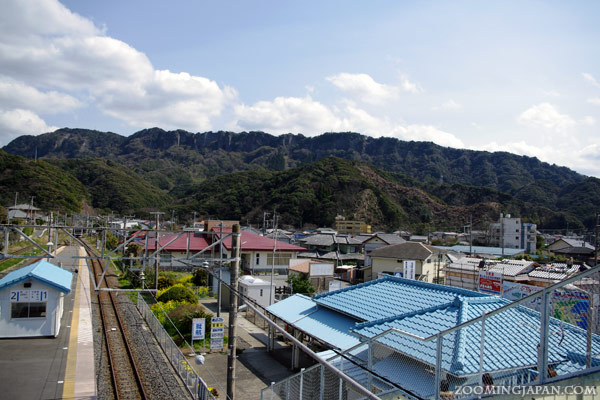
Nokogiriyama can be easily accessed from Chiba, Yokohama or Tokyo.
It’s very common to go there by ferry or by train. I came by train and left by ferry!
Access to Nokogiriyama
By Train:
Get off at JR Hamakanaya Station. From Chiba it will take about 80 mins. If you want to access from Yokohama or Tokyo, the ferry might be the better option!
You can also access via JR Hota Station, but the hiking trail from there might be confusing, so you better take a map with you! If you’re in a hurry, I don’t recommend this approach!
By Ferry:
You can also access via the Hamakanaya Port’s ferry terminal.
From the Keikyu-Kurihama Station (south of Yokohama) you can either walk (20 mins) or take a bus to the Kurihama Ferry Terminal. From there the trip with the “Tokyo Wan Ferry” (東京湾フェリー) will take about 40 mins.

From either the Hamakanaya train station or the ferry terminal it’s a short 10-15 mins walk to the Nokogiriyama Ropeway.
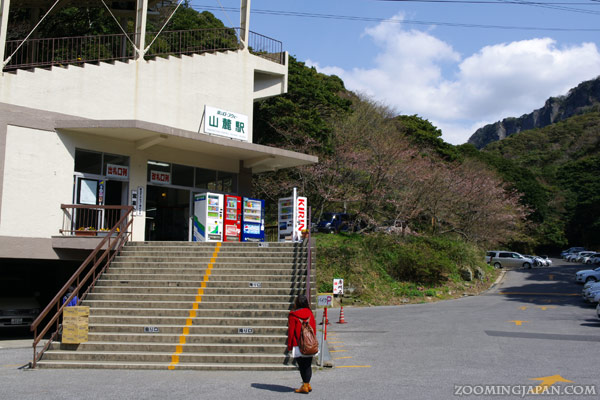
That’s the entrance to the Nokogiriyama Ropeway Station. You can purchase one way or round trip tickets (for more information scroll down to the “Tourist Information box” at the end of this blog post).
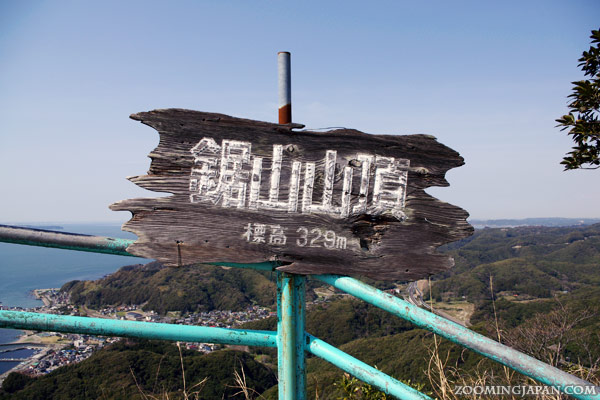
The trip with the ropeway is rather short. After all Nokogiriyama is only at a height of 329m!
Nokogiriyama (鋸山) aka Mount Nokogiri literally means “saw (鋸) mountain (山)”. The name represents the mountain’s distinctive feature as it looks like a Japanese saw. This shape was formed in Edo period. People worked hard to build the biggest city of Japan, but there was only marshy land, so solid rocks were necessary to create a strong foundation for the buildings of Edo. Mount Nokogiri’s current shape clearly shows the hard work of all those people.

Although the mountian isn’t very high you’ll get some breathtaking views from up there!

Mount Nokogiri offers a spectacular 180-degree panorama!

Here you see Jigoku-nozoki (地獄覗き, “peering into hell”) a small rock platform which sticks out over cliff.
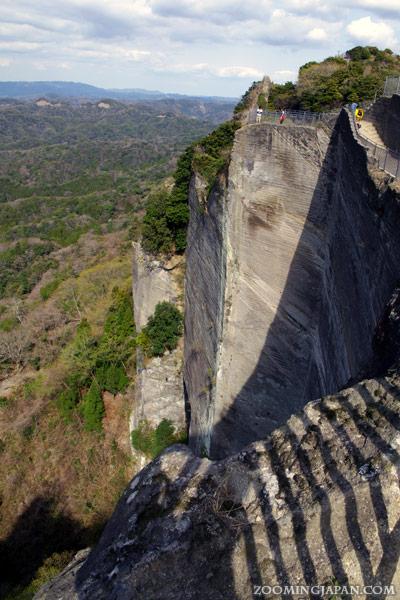
You DON’T want to fall down there!

The panoramic view from up there is really stunning!

Nokogiriyama has to offer more than just a great view! There’s also the Nihon-ji Temple (日本寺) complex which houses a big Buddha statue (Daibutsu).
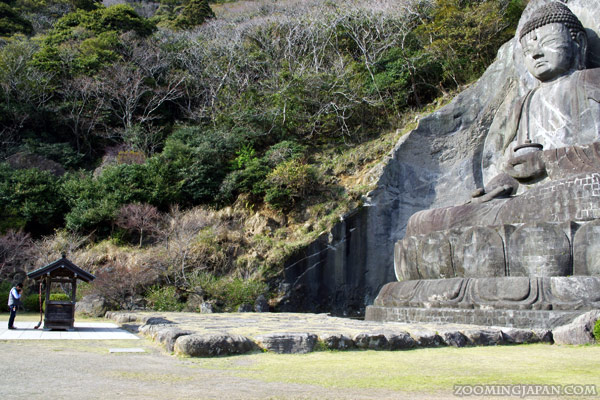
As the largest pre-modern, stone-carved Daibutsu in Japan (31.05m) it’s taller than the famous Buddha statues in Kamakura (13.35m) and Nara’s Todaiji (18.18m). It’s in fact one of the largest Buddha statues in Japan. Nihon-ji Buddha is the seated image of Yakushi Nyorai, the Buddha of healing and medicine, dating back to the late 1700s. It was damaged due to an earthquake, but fully restored in 1966.

Nihon-ji Temple, also known as “Kenkonzan Nihonji” (乾坤山日本寺), was founded in Nara period in 752. Since then the temple complex has been damaged and rebuilt several times. It’s considered to be the only temple in the Kanto region that was built by the order of the emperor during the Nara period.


Right next to the great Buddha statue was this smaller Jizo stone statue, looking over millions of tiny jizo statues!
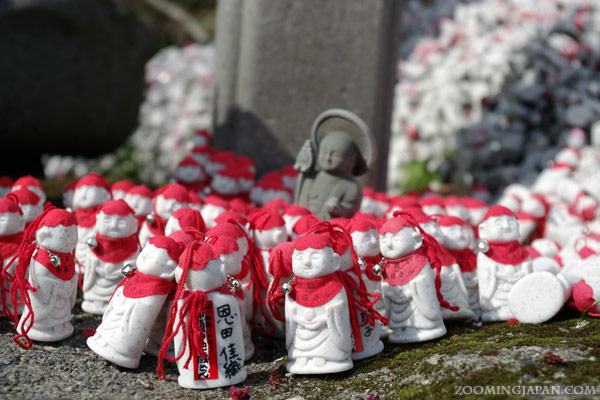
Jizo (地蔵) are the guardian of children and the bodhisattva of Hell.
These tiny white jizo statues are called “Onegai Jizo” (お願い地蔵). People buy them to make a wish or ask for help and then put them around the main Jizo statue.
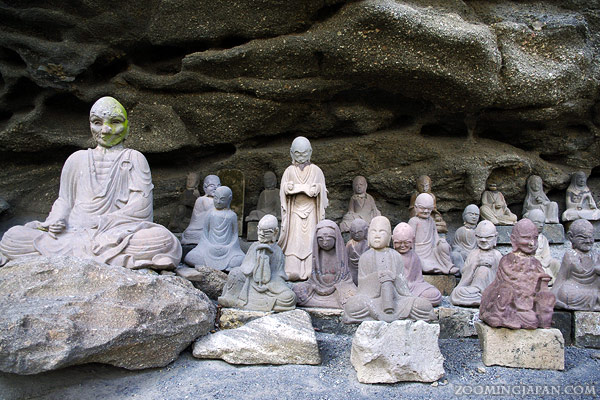
If you visit Mount Nokogiri you won’t just get a great view from above and see one of the largest Buddha statues in Japan, there are also about 1500 hand-carved statues of Rakan (千五百羅漢道).


Each of them is unique with its own facial expression and gesture!
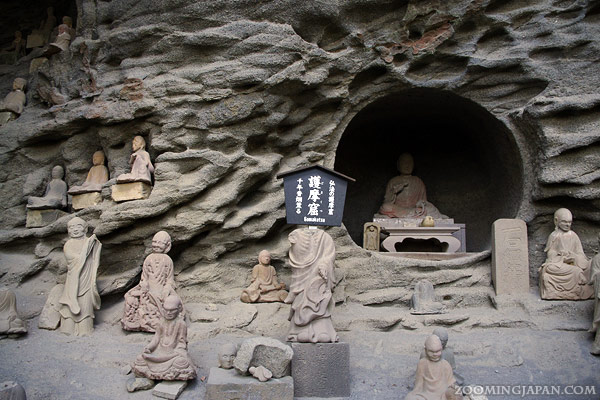
During the anti-Buddhist Haibutsu Kishaku movement (1868~) many sculptures and facilities of Nihon-ji were damaged. Quite a few of the Rakan statues were beheaded at that time.

Another famous spot where you can see a lot of Rakan statues like that is the Otagi Nenbutsuji Temple in Arashiyama (Kyoto).


From the great Buddha statue there’s a trail that will lead you to all these fabulous stone statues.
On the left you can see “Asekaki Fudou” (あせかき不動). I really fell in love with the statue because of the different eye color!
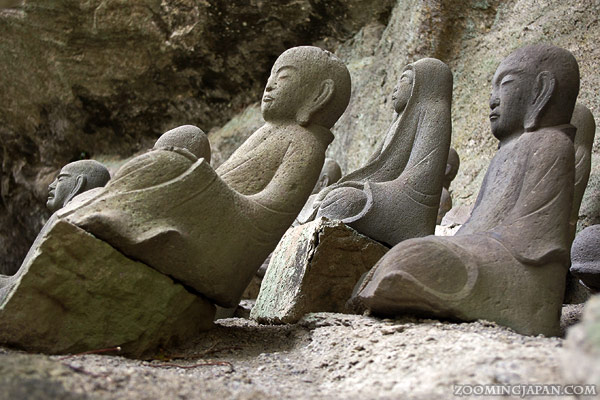
There are a lot of stairs, but there’s so much to discover, so I highly recommend you take your time there!
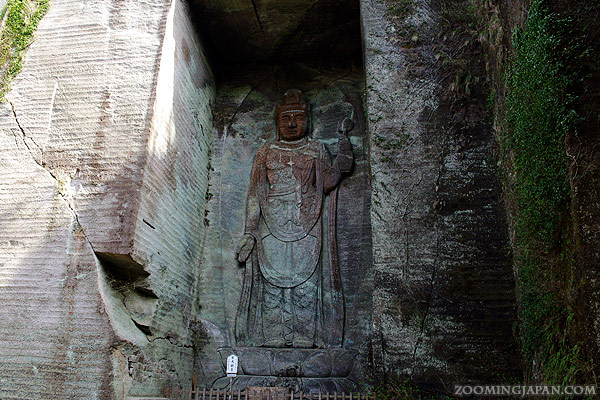
The trail will finally lead you to the “Hundred-shaku Kannon” (百尺観音) which was carved as a memorial and prayer for vicitms of WWII. It took 6 years until completion (1960-1966). Nowadays people pray to this huge relief image of Kannon for traffic and travel safety.


The Hundred-Shaku-Kannon is 100 shaku high. Shaku (尺) is an old Japanese (Asian) unit of measure. 100 shaku are about 30m.









I’ve seen pictures of that Buddha but had no idea where it is. I might actually make a trip there next time I’m in Tokyo. I think you forgot to finish the info on the entrance fee. I assume it’s “half price for children”?
I just love Japan, there’s so much to discover! The slogan for once fits, it’s really endless discovery.
It’s really easy to go there from Tokyo.
I guess most people just don’t know about it – which is a shame!
I hope you’ll get to go there next time you visit! :D
Thanks, I fixed it! (^__^”)
Quite an interesting place. I am a bit indifferent to large Buddhas, but I thought the Rakan statues were lively and had personality. The view is quite nice as well.
I will be visiting Otagi Nebutsuji this spring, so I look forward to seeing some Rakan there. I had thought just had Jizo statues.
You mentioned the Haibutsu Kishaku movement. I really knew next to nothing about it, so it prompted me to look it up. I understand better now the lack of upkeep and attendants at the surviving Buddhist temples.
I haven’t been to the one in Arashiyama yet, but judging from the photos, I think the Rakan statues there are even more interesting!
I’ll definitely check them out this year! :D
I didn’t know about it either. It’s great that I learn new things while writing blog posts and it’s great if my readers learn something, too! ^___^
I visited Nokogiriyama when I lived in Chiba, thanks for bringing back memories.
You are very welcome! Sounds like you really enjoyed your time there! :)
Wow, das schaut wirklich toll aus! Kommt auf meine To Do Liste! ;P
Liebe Grüße!
Die Kirschblütenfee
Freut mich! Von Yokohama aus ist es auch wirklich nicht weit! Für dich also perfekt! *g*
Ich war nun auch da!!!!! Es war wundervoll, danke, danke, danke für den Tipp. :fan:
Meinen Bericht kannst du hier nachlesen:
http://kirschbluetenwunderland.blogspot.jp/2013/04/sightseeing-japan-nokogiriyama.html
Liebste Grüße,
Die Kirschblütenfee
Vielen Dank für den Link!
Du konntest ja wirklich viele tolle Fotos machen. :)
Freut mich, dass es dir gefallen hat. ^____^
Another place I’ve got to visit. The view from top of Nokogiriyama looks amazing and the so much to see there as well.
I’m sure you’ll enjoy it! I was surprised to see how much there was to discover when I visited!
Very cool! I’m always amazed by the detail in stone carvings..! :sparkling: And I love those views from the top of the mountain..! I wonder if you can hike up to the top as well.. (I have this weird obsession with hiking up mountains ever since I went to the one in Miyajima in high school lol). Great photos as usual! :kyah:
Oh yes you can hike it! You wouldn’t get off at the same JR station as I did (see the “access information” above).
I would have done that if I had had more time! :)
Great photos, and useful information provided. I just visited Nokogiriyama earlier this month. Like you mentioned, lots of stairs, but so much to discover — worth the effort. Just like to add that Mt Fuji can also be seen from the observatory platform outside the top ropeway building, depending on the weather.
Thanks for the information about Mt. Fuji.
I wasn’t lucky and couldn’t see Mt. Fuji that day, but we aren’t really friends. Mt. Fuji loves to hide from me whenever we have a date! *g*
Hi!
Thanks for your recommendation! Me & my husband will be going there this coming July!!! Hooray!!!
Hey Irene!
That’s great! I’m sure you’ll love it!
I hope you’ll have great weather and an awesome day! ^___^
[…] ZoomingJapan: Nokogiriyama and Nihonji Daibutsu in Chiba […]
Fabulous information thanks! Just starting some early planning for next winters trip and this is definitely on the list but has been difficult to find much information on – which is good, hopefully that means will not be too full of tourists. Hoping for a lovely clear day like you had for some great photos too.
If you’re going in winter (apart from Dec 29 – Jan 4) it shouldn’t be too crowded.
I hope you’ll enjoy your trip. ^__^
Impressive. I only discovered it when I was walking in Shibu Onsen at Yamanouchi town. I saw a photo on a shop window which was closed, so I copied down the information in Japanese and show it to the tourist information centre at Yudanaka train station. The information officer do a search for me and found it in Chiba. I told myself I need to go there before I go home. I managed to visit the place last Friday. I didn’t know there is such a rock carving Buddha image in Japan other than the one in Oita, Kyushu. I was actually on a Buddha hunt mission in Asia, not for anything, just for fun. Certainly I will add this one in my Panaromio collection.
Japan has a lot of hidden gems. I’m glad you found it before you left. ^___^
Hi there..
Need your advise.
I will be going to Nokogiriyama by train from Tokyo and would like to take a ferry from there to Yokohama.
I understand we can do that right? But I am not too sure of the route..can you advise me please?
Thank you
Hello Janet,
Yes, you can absolutely do that.
The ferry will take you to Kurihama on the Miura Peninsula in Kanagawa Prefecture, from there it’s not too far to Yokohama (or then back to Tokyo).
Please note that the last ferry leaves at 7:30 p.m.
Btw. the Miura Peninsula is also lovely. I just visited Jogashima (from where I could see Nokogiriyama in the distance) and LOVED it.
If you have some extra time, maybe stay in that region and explore some more.
Enjoy! ^_^